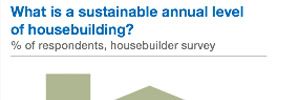 Less than one in ten house-builders believe it would be possible to deliver more than 200,000 homes a year, every year under current conditions, according to a new study.
Less than one in ten house-builders believe it would be possible to deliver more than 200,000 homes a year, every year under current conditions, according to a new study.
The findings of Knight Frank’s annual house-building survey for 2015 found that only 9% of the 160 respondents felt that it was possible to deliver more than 200,000 new homes on an annual basis. In addition, more than two thirds (67%) say the maximum number of units that the market can deliver is only 180,000 or less.
At a time when housing has become a key battleground of the General Election, these findings place serious doubt on the housing targets set but the main political parties. Labour plans to deliver 200,000 homes a year by 2020, with 1m homes under construction over the course of the next Parliament, while the Liberal Democrats would hope to deliver 300,000 new homes annually. While the Conservative Party has been running on a policy of letting local authorities set housing targets, its plans would also see hundreds of thousands of new homes built.
Knight Frank says that while it expects house-building levels to grow in the coming years, it is unlikely to approach the levels targeted by the main political parties.
In 2014, 118,760 homes were completed in England, with construction beginning on around 137,000. While this is historically low, Knight Frank’s survey suggests that in the current market, house-builders do not believe that the number of homes being built annually can reach much higher.
This is due to several constraints identified in the report that are likely to block higher levels of residential construction, most notably the issue of capacity. Justin Gaze, joint head of residential development at Knight Frank, explained: “The single biggest constraint to increasing the delivery of housing in the UK is the lack of capacity in the development industry. Developers are responding by increasing their workforces, but this is a slow process and supply is unlikely to rise quickly.”
Cost is also considered to be a main issue blocking the delivery of new homes, with nine out of ten respondents expecting construction costs to rise over the next 12 months, with nearly 60% expecting price rises of between 5-10%.
A large part of these cost rises have been attributed to a shortage of labour, with 94% of respondents saying that the current cost and availability of labour was a risk to the industry. Around 40% of respondents said the risk was significant, 42% said it was moderate, and the survey also found reports that the current lack of an available workforce is already hampering activity.
When asked what policy change could help boost development volumes, the most popular suggestion was to recruit more people to Local Authority planning departments in an attempt to speed up developments.
To read Knight Frank’s report in full, click here




